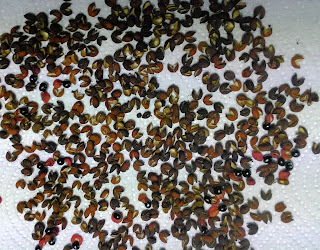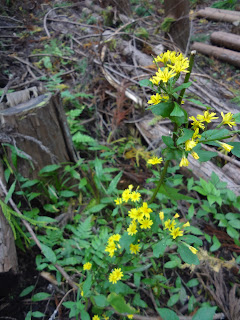Japanese cuisine is of soy source and miso paste, generally. We are not so conscious for spices. I’ve just counted how many seasoning we have that can be called as “spice.” Hmmm … Wasabi, aka Japanese horseradish, that is surely endemic in Japan. To cultivate the plant, we need damned pure and cold water flowing over graveled river bed so that the growing district of Wasabi is always near or in mountainous national parks with high altitude. Shichimi is in the end a sub-product of red chili peppers coming from America … Well, our mustard is made of mustard seed powder and water w/o vinegar, so I consider it as Japanese specific, but mustard itself is universal … We have ginger powder, but using ginger as spice would be something of recent introduction; for Japanese recipes, here is the list of popular dishes with ginger powder, but none of these are so-called “traditional” Japanese food ... We have pickled, dried, and powdered leaves of beefsteak plant that is often used for Japanese traditional meals (recipe, here). I first thought the plant is Japanese endemic. Nope. It is said that they were imported from China, and used extensively in Southeast and East Asia. OK, … what’s else? Oh, yeah, we have Japanese cinnamon (Cinnamomum sieboldii Meisn.) which does not contain eugenol, a particular ingredient for tropical cinnamon (Cinnamomum verum or Cinnamomum cassia). If you’ve been to Kyoto, you’ll find a ubiquitous triangular sweet, Nama-Yatsuhashi, made of sticky rice crepe with the taste of cinnamon. That’s not with tropical cinnamon, but with Japanese cinnamon that is made of roots, not bark, of the tree. As such, the number of available Japanese cinnamon trees is dwindling fast these days ... oh so dangerous appetite of ours …
 |
| A large
Japanese cinnamon tree survived for all of these years in Kanagawa Prefecture … |
What’s else do we have as Japanese “spice”? There is one naturally growing very near from our home in Yokohama. That’s Sansho, Japanese pepper. The most widely known aroma of this spice is as condiments for Kabayaki eel. Can you recall that spicy but lemony scent of the powder you find in a small packet attached to the frozen Kabayaki in your nearby supermarket? That’s Sansho. Actually, we can find a tree of Sansho in a garden of our neighbors. The tree grows also in the southern provinces of Korean Peninsula, but the origin of the species is in this archipelago. For one thing, it has odd−pinnately compound leaf with opposite thorns on its trunks and branches. i.e. Very good for protecting houses from intruders. (Why do I mention the order of leaves and thorns here? More for that, below.) In addition, the whole body of the plant has that particular aroma that is not at all bad to waft in our garden. The trunk of a tree with about 3-4cm in diameter can be a very good pestle that can yield the citrus scent to your dish. In early spring when its leaves are young, soft, and edible, we can pick them for salad or food decoration as herbs. In early summer, the tree bears small green and young fruits which can be stewed to be condiments of Japanese cuisine (recipes, here; I warn you, it takes at least two days to complete the entire process). In autumn, we collect ripen red berries to make powdered spice (; recipes with powdered Sansho, here.) Not many Japanese know how the ripen berries of Sansho becomes the condiments for Kabayaki. Actually, I didn’t know it until recently, but found out it’s soooooo easy to make. Here is the How-to.
 |
| The
green bottles are supermarket version of Sansho Powder. |
 |
| The
pestles in the bottom of the left of this photo are made of Sansho tree. |
 |
| A
Sansho tree in spring. The leaves are young and suitable for salad. |
First, you have to find Sansho tree in a forest near your place. As the entire body of the plant is very useful, many landlords are protective for their tree. Before entering the forest, you’d better check with the police or somebody who knows the owner of the place if it’s OK to collect some fruits or leaves from the forest. Next, we have to find the tree. In a Japanese ordinary forest, there are 3 similar-looking trees with thorns and odd−pinnately compound leaves. All are in the family of oranges, dioecious, and their flowers waft sweet scent. They are equally homes for larvae of many kinds of swallowtail butterflies. But, only the berries of Sansho, aka Zanthoxylum piperitum, can give us worthwhile aroma for dishes. The characteristics of a tree of Sansho is “odd−pinnately compound leaves with opposite thorns on its trunks and branches.” Remembering it is the first step to find a tree. It’s also useful to know the features of the other two.
 |
| A Sansho tree with red berries in September. They are still young as we cannot find many opened fruits. |
The one for another two, Fagara schinifolium (in Japanese, Inu-zansho) cannot produce enough kick as a spice. To find one, if we encounter odd-pinnately compound leaves that look suspiciously for Sansho, but its thorns are locating alternately along the trunks and branches, that’s Inu-zansho. Another “not Sansho” is Fagara ailanthoides, Karasu-zansho in Japanese, which would be easier to find in a forest than the other two. It’s a pioneer plant. In Yokohama, when people thinned trees and do not mow the opened ground during summer, the site will quickly turn into a forest of spiky Karasu-zansho. When a tree is young, the leaves of Karasu-zansho look very similar to Sansho, but its thorns are decorating the body of the tree really randomly, not in the opposite order as Sansho. It’s easy to identify Karasu-zansho in this way. Karasu-zansho can be a large tree once it can survive in a wild competition for continuous supply of sunshine. Sometimes, in a well-established forest long-past the pioneer stage from the disturbance, we can find a tree of Karasu-zansho of more than 10m tall and 30cm or so diameter, with very large “odd−pinnately compound leaves.” During fall, its fruits spread sickeningly sweet scent that is popular among birds. Their aroma has certainly a connotation of food decay, and, because of this perhaps, I could not find an article for human consumption with the berries of Karasu-zansho. Though, during early spring, their young leaves can be eaten for Tempura, and their branches can be a pestle after removing the thorns. Flowers of Karasu-zansho can give honey of very soothing taste, and so apiculturists love to find large flowering Karasu-zansho trees near their beehives. VERY interestingly, when Karasu-zansho becomes big and old enough, it loses its thorns … it’s nearing to nirvana, maybe, just like happily aging senior citizens of human world …
 |
| It’s
really difficult to identify it’s Sansho or Inu-zansho, unless you come close and check the way the thorns deployed on the branches and trunks. Answer: Inu-zansho. |
Now you have obtained OK from the landlord for a bit of offerings from their forest, and found a Sansho tree. If that’s early spring, prick few leaves and sprinkle them over your simply cooked pasta. Mission accomplished. If you find green Sansho berries in June, collect some, and stew them to accompany with your traditional Japanese summer dish. Sansho berries turn to bright red in late September. One day, maybe in October, they open the mouth and dangle a small black seed from the red husk. Their red quickly fades to greenish brown. That’s the time to harvest Sansho spice. Carefully collect the berries with open mouth, and dry them in chilly but sunny October air. It’s OK to mix not-yet opened red berries for drying. If they are dried completely, the red berries open their mouth and show black seed poking from the brownish husks. Separate the husk from the seed, and store the husks in pepper mill. Mission accomplished. Yes, Sansho spice is not from the seed, but from the husk. Although we can buy Sansho powder in ordinary Japanese supermarket, the aroma of the spice will be lost rapidly once you powder the husk, The ideal way to enjoy simultaneously zesty and citrus flavor with Sansho spice, you’d better mill the husks just before you eat the dish. So, we use pepper mill to crush the husk for just sufficient amount of Sansho powder at the time. Please try. If you can collect enough Sansho berries for 3cm*4cm*4cm tapper ware, you would have enough Sansho spice for a year until we have another fresh supply of red Sansho berries. It’s not much, really. Forest in Yokohama can be this generous. (Japanese recipes using Sansho is here. Google translation can be handy. 😋) Oh, by the way, Chinese Sichuan Pepper (Zanthoxylum bungeanum) is not Japanese Sansho: they taste different each other, in definite.
 |
| This
year I’ve harvested Sansho from this tree which had this red berries, and |
 |
| … open
mouthed ones. Could you figure out black seeds dangling from the husk? |
 |
| My
harvest for 2018. Could you see some red berries included here? |
 |
| All
berries, including the red ones, will open their mouth eventually after drying. They are now ready to be … |
 |
| … stored in a pepper mill. |
 |
| Actually,
a luxurious version of commercial Sansho powder is sold in this way, in a mill just like mine. It’s 5 times more expensive than the supermarket version. Wow. |
 |
| Pertya robusta in Niiharu Citizen Forest. It’s endemic in Japan. |
If you find an environmental issues
in Kanagawa Prefecture, please make a contact with Kanagawa Natural Environment Conservation
Center 神奈川県自然環境保全センター
657 Nanasawa, Atsugi City, 243-0121 〒243-0121 厚木市七沢657
Phone: 046-248-0323
You can send an enquiry to them by clicking the bottom line of their homepage at http://www.pref.kanagawa.jp/div/1644/


No comments:
Post a Comment